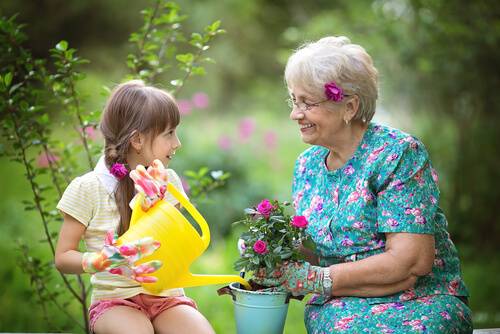
Page contents
- What is intergenerational care?
- What are examples of intergenerational activities?
- Care home resident: ‘It makes my day when the children come’
- ‘The idea older adults can’t learn from younger generations is a myth’
- What are the benefits of intergenerational care for elderly people?
- How can I find care homes that offer intergenerational care?
- Top 10 tips for intergenerational care
Page contents
- What is intergenerational care?
- What are examples of intergenerational activities?
- Care home resident: ‘It makes my day when the children come’
- ‘The idea older adults can’t learn from younger generations is a myth’
- What are the benefits of intergenerational care for elderly people?
- How can I find care homes that offer intergenerational care?
- Top 10 tips for intergenerational care
Intergenerational care homes bring together people from different generations for planned, social intergenerational activities and this article highlights the benefits of intergenerational care for those taking part.
What is intergenerational care?
Intergenerational care usually involves children visiting older people in a care home to socialise and participate in activities together.
Intergenerational activities take place to enhance the quality of life for residents in care homes, but also has benefits for children.
Such activities give older people opportunities for socialising, mental and physical stimulation, emotional support and personal growth.
Many care homes have planned visits from young children and teenagers from local nurseries or schools. Residents spend time talking, playing and taking part in activities with the children.
What are examples of intergenerational activities?
Care home residents and children may share experiences such as:
- Arts and crafts.
- Reading books.
- Reminiscing and telling stories.
- Sing-songs and dancing.
- Imaginative play.
- Shared games.
- Gardening.
- Cooking sessions.
- Walks together.
- Celebrating festivals together.
Care home resident: ‘It makes my day when the children come’
Little Wrens Day nursery and pre-school is situated in the village of Selston, Nottinghamshire. It is attached to Wren Hall Nursing Home, where intergenerational care is offered.
A staff member, who took a group of two-year olds into Wren Hall Nursing Home, recalls how the face of one of the women living in the care home ‘lit up’ at the sight of the children.
The care home resident asked the children: “Have you come to see me?” and one of the children excitedly replied “Yes”.
The staff member said: “The lady had the biggest grin on her face and said: ‘It makes my day when the children come’.”
An intergenerational care home is a mixed age setting where a nursery is set up within a residence for older people.
The South London nursery Apples and Honey Nightingale Nursery is based at Nightingale House residential care home in Wandsworth.
It is an intergenerational setting – with young and old located together, sharing facilities and interacting with each other every day.
Some care home residents have told staff that being around the children has given them a reason to live, to try to exercise more and keep up their energy levels.
‘The idea older adults can’t learn from younger generations is a myth’
At Wren Hall Nursing Home, children from Little Wrens Day nursery meet with the care home’s residents, eat together and enjoy activities.
“The idea that older adults can’t learn from younger generations is a myth. In fact, both parties benefit from the exchange of knowledge and experiences” said Anita Astle managing director at Wren Hall Nursing Home.
“Intergenerational care breaks down stereotypes and promotes empathy and understanding between generations.
“It is a beautiful way to create meaningful connections and enhance the quality of life for everyone involved.”
What are the benefits of intergenerational care for elderly people?
When people of different generations spend time together, the impact has many positive effects and advantages for all ages.
Wren Hall care home staff say care home residents “don’t stop smiling” during intergenerational sessions. “A picture speaks a thousand words and looking at the photos we take, you can see the happiness on both faces”.
Older adults in care homes who participate in intergenerational activities, according to research, benefit from:
- Significant improvement in mental health and emotional wellbeing.
– People feel less lonely or socially isolated as intergenerational activities builds friendships, close emotional bonds and more social connections.
– Lower rates of depression and anxiety.
– A more positive self-image. A person’s self-confidence can increase significantly.
– Increased dignity.
– A better outlook on ageing.
– Feeling hopeful about the future.
– More socially-engaged and interested in life and events happening around them.
– An improved sense of purpose.
A study in Ageing & Mental Health found intergenerational work also provides care home residents with a sense of purpose in their lives. This is associated with an improvement in mood and a feeling of having more control in their life.
Older people can take on the role of carers during intergenerational activities and help children in tasks such as completing pictures, looking for things, showing concern if they fall over, etc. In this way older people can have a renewed sense of purpose.
- Stronger community links.
– Intergenerational practice can help to build stronger, more inclusive communities by promoting understanding and cooperation. This also helps older people feel connected and part of a community.
– Increased understanding and respect for different generations by learning more about different age groups.
– Reduces ageism by reducing experience of negative stereotypes and prejudices. It breaks down barriers between the generations.
- Improved physical health.
– More physically active. Compared with those who do not, care home residents who regularly take part in intergenerational activities with children, according to research, burn an average of 20% more calories per week.
– An increase in physical activity is linked with a longer lifespan and less risk of developing health problems.
– Experience increased mobility and flexibility.
– Experience fewer falls.
– Rely less on a mobility aid such as a cane.
- Improved cognitive function.
– Research suggests that intergenerational activities sharpen the mind.
Some older adults may perform better on memory tests than those who do not. Those with cognitive impairments,such as dementia, experience improvements when interacting with children as opposed to engaging in other activities.
– Learning and remembering opportunities. The young teach the older people and the older generation teaches the young. Playing with children creates the opportunity to learn skills and remember old ones. For example, playing computer games and playing a musical instrument.
A spokeswoman for Wren Hall care home said: “The memories that cause a sparkle in the ladies’ and gents’ eyes are memories that the children have yet to make.
“For example, talking about going on holiday can support our family members in reminiscing and cause feelings of excitement in the children.”
From 2019-2022, the Care Home Friends and Neighbours: Intergenerational Linking project brought together over 4,000 young people aged 5-14 from schools and youth organisations with 2,000 older people living in care homes across England.
The project is a partnership between My Home Life England and The Linking Network and was partly funded by The National Lottery Community Fund.
You can hear about some of the project’s intergenerational ideas that took place during Covid-19 pandemic below.
How can I find care homes that offer intergenerational care?
If you are interested in intergenerational care, you can contact care homes in your area to enquire about any intergenerational activities.
Top 10 tips for intergenerational care
Here are 10 tips on what people should keep in mind when it comes to effective intergenerational care.
- Go with the flow – let children be curious and inquisitive.
- Let children lead the interaction.
- Give older people the space to express their thoughts and engage with children.
- Teach both the children and residents to respect personal boundaries and to ask for permission before touching or hugging.
- Encourage them to have fun as it is an opportunity to make new friends and create meaningful connections.
- Adapt activities and make use of common interests.
- Use photo albums to allow ages to connect and find similarities with each other and boost memory e.g. visiting the beach/Christmas photographs.
- Everyday tasks can be used as intergenerational activities as both children and elderly love cooking, baking, gardening, singing and looking through books.
- Make use of items that can spark interaction e.g. a doll, jewellery.
- Be prepared for older people and young children to form close bonds.
Find your ideal care home
- Explore a wide range of care options and facilities
- Read independent ratings and reviews
- Connect directly with care homes to book a tour and discuss your needs


